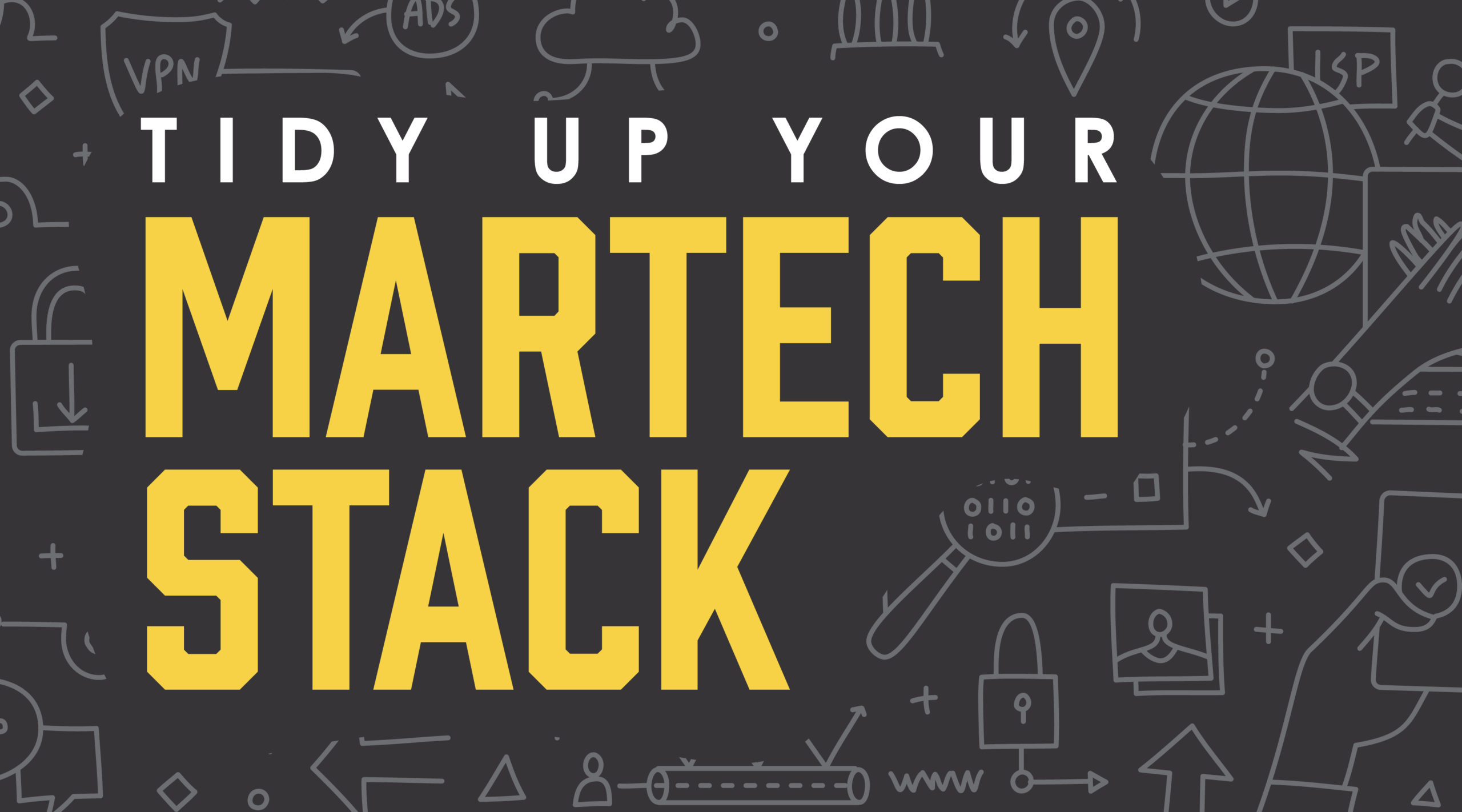Technology touches every aspect of a company—and nowhere is that more apparent than when it comes to your marketing activities. These days, marketing and technology are so thoroughly intertwined that a whole new word was coined to define this space.
Though it might sound vaguely like the villainous corporation in a post-apocalyptic sci-fi flick, “martech” refers to the suite of technologies used by marketers to plan, execute, and measure their activities. (That’s marketing + technology—think “Bennifer” or “Brangelina,” not Dr. Evil’s Virtucon Industries.) As the portmanteau implies, marketing simply cannot exist without the integrated “stack” of technologies that enable it.
Today’s consumers expect a highly personalized experience, and your ability to deliver will be determined by your martech stack. That includes an alphabet soup of software from CMS (content management systems) to CRM (customer relationship management)—plus marketing automation, business analytics, and all the other interconnected programs, apps, platforms and tools that define the functionality of your customer experience.
Your martech stack will determine the scale of your capabilities, and it will eventually determine your outcomes. If it’s not aligned to your business objectives and strategies, you’re just spinning your wheels… and flushing dollars down the drain. Read on to learn how you can tidy up your martech stack and ensure that you are maximizing your technology investment.
The Business of Change
We all know the only constant in life is change. This is especially the case at the intersection of technology and business:
- Your business may have grown beyond the capabilities of your current software.
- New functionality may be needed to achieve your business objectives.
- Current functionality may be obsolete or unnecessary.
You may even have business problems yet to be discovered. Drill down into the numbers, and you might find subtle signs that something’s amiss. Are you seeing an increased rate of unsubscribes? Perhaps your customers are not getting emails that are relevant to their needs. Are your business leads declining? Has there been a tangible decrease in your online sales? That could be a sign of a stagnant business, but it could also be as simple as a misaligned piece of software.
Start With Strategy
Businesses cannot achieve every goal through technology alone, but technology can go a long way when it’s working for you. The key to harnessing its power is to use it correctly. And that requires strategy.
Flashback: Strategy and Technology: The Chicken or the Egg
If you take away nothing else from this article, be sure to define your strategy before you invest in any technology solutions. Otherwise you may find yourself force-fitting your strategy simply because you’ve already made the investment. That often ends up costing more time and money—and you still may not even meet your goals. That’s a recipe for disaster!
Instead, start by setting technology aside altogether. This takes the “sunk cost fallacy” off the table while eliminating any biases you may have toward your current ecosystem. Even better: bring in an outside expert who can serve as a neutral third party. Then work through the following checklist:
- What are your business objectives and strategic goals (both short- and long-term)? What is the destination at the end of this journey? Assess your resources and prioritize what’s most important.
- Next, think through your customers and their touchpoints with your brand. Start with personas to understand your customers, and customer journey mapping to understand how your technology should enable an ideal customer experience.
- Identify what content is needed to support your customer across their journey, and what data is needed to deliver that content at the right time, in the right context.
- Finally, you’ll want to build a measurement plan to assess and evaluate your solutions as they are implemented. Avoid “vanity” metrics and instead select powerful key performance indicators (KPIs) to forecast what success should really look like.
Audit Your Current Landscape
By starting with your business objectives and strategic goals, you now have a crystal-clear lens through which to evaluate both current and prospective technologies. With strategy as your fuel, your martech stack is the vehicle that will drive you to your destination.
You already have clear, detailed documentation of your current technology environment, infrastructure and workflows, right? Of course you do! (If you don’t, now is the time to conduct a proper assessment.)
Walk through your current technologies and document the “why.” Pull relevant metrics to see what’s working and what’s not so you can make data-based decisions. For each component, ask:
- Why is it needed? To which business objective(s) does it align?
- Does it integrate smoothly with other technologies?
- Are there gaps in desired functionality?
- Are you utilizing it to its fullest capabilities?
- Are its features duplicated elsewhere?
Mind the Gap
Next, you’ll want to conduct a gap analysis to determine the distance between your current and ideal states. For each business priority, identify and engage your stakeholders. Talk to the people who are actually doing the work, day in and day out. What are their pain points? Do they have everything they need to deliver the desired outcomes? If not, is it really a tech problem… or is it the lack of user training?
Remember: the gap analysis is more than a technology audit. Think holistically about how each component relates to your business objectives, processes, and staff competencies:
- Do any of your processes need to be fixed, optimized, replaced, or eliminated? Make sure you’re not doing it just because “that’s how we’ve always done it.”
- Do you have the right team in place not only to implement the technology, but to support and maintain it?
- Make sure you have proper governance (policies and rules for workflow, user roles, approvals, etc.) to ensure the technology remains in line with your business needs.
- Lastly, don’t forget Even the best products are only as good as their users!
Research and Recommend
In looking to your desired future state, you’ll want to research competitive technologies and dig deep into their capabilities. After all, you must know what else is available before you can compare it to what you have! Even if you aren’t looking to replace a given component, you may not know whether better solutions exist until you go looking for them.
Alongside your IT team, engage your stakeholders to brainstorm options, assist with research, and participate in free trials. Have them compare features, pricing and scalability—and make initial recommendations to address the gaps. Those recommendations should include some analysis of the effort involved in taking those steps, as well as any challenges that would need to be addressed. (Don’t forget to account for future growth.)
Prioritize, Implement and Measure Success
With recommendations in hand, prioritize those that offer the most impact for the least effort—and make sure it fits your budget. Consider the costs of migrating to a new platform or tool (user training, lost functionality, data conversions, etc.) as well as the costs of not switching.
Once you’ve decided on a path forward, you’re ready to create a roadmap for implementation that minimizes downtime to your key processes. Don’t try to do everything at once! Take a phased approach and break it down into manageable components. Make sure one phase is going well before moving on to the next.
Although your IT team will lead this phase, you might consider engaging an implementation partner for assistance. Besides reducing the burden on your internal staff, their core expertise can speed up implementation and save you many hours of work (and potential rework, plus multiple migraines) so you can hit the ground running.
Once everything is in place, you’ll want to measure the business impact, both short- and long-term. Remember those KPIs we set during measurement planning? Here’s where they come back into the picture. The impact of any new implementation should be significant and measurable. After all, there’s a reason you spent all this time to ensure you aligned your technology investment to your business strategy!
At the end of the road is an integrated and optimized martech stack, fully aligned with your business strategy, primed for growth and expansion.
Is it time to review your company’s martech stack? If you’re not sure where to start, we’ve got stacks of smart people ready to help!





